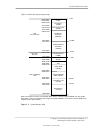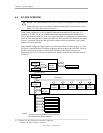
Chapter 4 System Support
4.2 PCI BUS OVERVIEW
NOTE: This section describes the PCI bus in general and highlights bus implementation
in this particular system. For detailed information regarding PCI bus operation, refer to
the PCI Local Bus Specification Revision 2.2.
These systems implement a 32-bit Peripheral Component Interconnect (PCI) bus (spec. 2.2)
operating at 33 MHz. The PCI bus handles address/data transfers through the identification of
devices and functions on the bus. A device is typically defined as a component or slot that resides
on the PCI bus (although some components such as the MCH and ICH2 are organized as multip
devices). A function is defined a
le
s the end source or target of the bus transaction. A device may
ontain one or more functions.
he AGP
PCI bus #1. All PCI slots and the NIC function internal to the 82801BA reside on
CI bus #2.
c
In the standard configuration these systems use a hierarchy of three PCI buses (Figure 4-1). The
PCI bus #0 is internal to the 815E chipset components and is not physically accessible. T
bus that services the AGP slot (or resident AGP controller on the Small Form Factor) is
designated as
P
Link Bus
M omponent
Bridge
Function
Mem. Cntlr.
Function
PCI
Bus #0
.
82801BA ICH2 Component
PCI Br
Func
I/F
Function
Controller
Function
I/F
Function
Controller
Function
Bridge
Function
Audio
Function
PCI Bus #0
AGP Connector
PCI Bus #1
(AGP Bus)
Hub Link I/F
PCI
Bus #2
PCI
Bus #2
PCI Connector 5 [2]
Hub Link
82845 CH C
AGP
I/F
Hub
idge
tion
EIDE USB SMBus LPC AC97
NIC
PCI Connector 1
PCI Connector 2
PCI Connector 3 [1]
PCI Connector 4 [2]
NOTES:
[1] Desktop and Configurable minitower models only
[2] Configurable minitower models only
Compaq Evo and Workstation Personal Computers
Featuring the Intel Pentium 4 Processor
Second Edition – January 2003
4-2


















